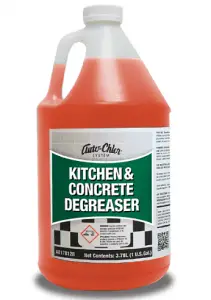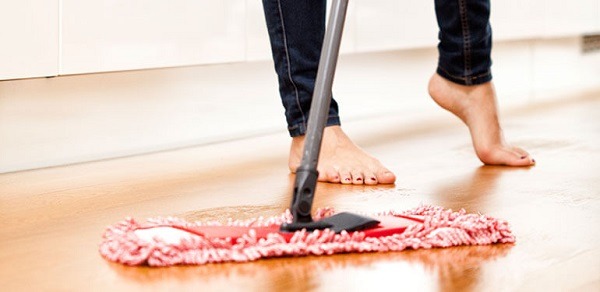The kitchen is one of the most frequently used rooms in the house. As long as you eat or drink in your house, it is inevitable that you will pay your kitchen a visit several times a day.
Consequently, your kitchen floor is more prone to getting dirty due to constant traffic. At times, kitchen floors can get stains due to several reasons.
So, whenever you notice such a problem, don’t panic. There is a broad spectrum of techniques that can help you get rid of kitchen floor stains.
Besides, it is not tedious to get rid of kitchen floor stains. All you need is just a little bit of patience and the right tools and techniques.
So, how do you restore a stained kitchen floor?
No products found.
Removing stains from a kitchen floor
The process of removing stains from kitchen floors varies depending on the material of the floor. For instance, if you have a marble floor, you would have to be keener due to its delicate nature.
On the other hand, ceramic tile kitchen floors are simple to clean. Let’s take a look at how to remove kitchen floor stains.
Removing stubborn stains
If you have stubborn stains on your kitchen floor that won’t come off using regular detergent, consider trying other techniques. But it would help if you first check the instruction manual of your kitchen floor. See if there is a prescribed method of removing kitchen stains from the floor.
Alternatively, you can ask your manufacturer about the best products to use when removing stains from your kitchen floor. Avoid using products like vinegar to remove stains on your kitchen floor. They can corrode your surfaces.
When removing kitchen floor stains, always make sure the floor is clean before applying any product.
Stains caused by tea, juice, wine and coffee
Remove tea, juice, and wine stains using hydrogen peroxide. You can use a clean cloth soaked in a substantial amount of hydrogen peroxide to wipe off the stained kitchen floor. Afterward, use a clean wet cloth to rinse the floor.
Eliminating grease stains

Occasionally, your kitchen floor is likely to get grease stains. Use a mixture of hot water and carbonated soda to wipe off the stain. Carbonated soda tends to break down grease particles, thus making them easy to wipe.
Depending on your floor type, you could also consider using a commercially manufactured degreaser to get rid of the grease. Degreasing reduces slipperiness of the floor thus increasing its safety.
However, ensure that you read the instructions carefully to see if the degreaser is recommended for use with your type of floor.
Removing permanent marker and ink stains
In case you have ink or permanent marker stains on your kitchen floor, you can use a dry eraser to get rid of the stain. When using a dry eraser, use a wet soft cloth or sponge to wipe the surface. Then wipe the surface with a cloth soaked in warm soapy water.
Alternatively, when it comes to ink stains, consider using a cloth soaked in hydrogen peroxide. Pat the stain with hydrogen peroxide until complete removal.
Wax, gum, and tar stains
Gum or wax stains can be very challenging to remove. So, if you get such kitchen stains, follow the below steps.
- First, you have to solidify the stain using ice. Pack ice in a substantial ice bag and let it sit on the stain for a few minutes. Let the stain get very cold.
- Then, take kitchen equipment with a blunt edge and scrape the gum or wax stain. Do this gently to avoid scratching the kitchen floor. Consider using wooden equipment to scrape off the wax or gun to avoid damaging the floor. While doing this, ensure you get rid of as much stain as possible.
- Afterward, use paint thinner to wipe off that particular area. Ensure that there are no traces of gum or wax stain. Then, rinse the area and allow it to dry.
Stains in the grout area
If you have stains on the grout, it can be challenging to get rid of them. Even so, you need not worry. Grout refers to the paste, often white in colour, used to fill the spaces in between tiles.
Home experts have invented several ways to get rid of stains in the grout area. Grout tends to absorb stains easily. Besides, they can make your kitchen floor appear dirty. So, let’s find out some of the ways to get rid of stains on the grout.
Apply a mixture of vinegar and hot water on grout

- When you notice a stain on your grout, use a clean cloth soaked in hot water to wipe off the surface first.
- Then, create a mixture of hot water and vinegar. Insert the mixture into a spray bottle.
- Afterward, apply the mixture to the grout area using the spray bottle. Allow it to get absorbed by the grout for approximately five minutes.
- Use a toothbrush with soft bristles to gently scrub the grout area; if you think the stain is intense, you would instead use an electric toothbrush to scrub it off.
- Once you finish scrubbing the area, use clean water to rinse.
Using a combination of baking soda and hydrogen peroxide on grout
Alternatively, you can use baking soda to remove grout stains on marble kitchen floors. Remember, marble floors are delicate. Thus, vinegar can be too harsh for them.
The first thing to do when using baking soda is to mix baking soda and peroxide solution in equal amounts in a spray bottle.
Afterward, apply the mixture of baking soda and peroxide to the grout area using a spray bottle. Then, use a suitable brush to scrub the stain. If you have a marble kitchen floor, avoid putting too much pressure on the floor while scrubbing.
- If you don’t want to use peroxide, mix baking soda with water. Then, spray it on the grout stain and leave it for approximately 12 hours. Then, scrub the stain using a soft brush.
- After scrubbing the surface, use warm water to rinse it off. Allow the grout area to dry for at least a day. Avoid tampering with the area after the stain removal process. It would be advisable to use a sealant to protect the grout from forming stains again.
Floor Protection Tips:
Never use any orange or ammonia-based, or solvent kind of cleaners since they can damage the luster and shine of your restored kitchen floor. But you can use a free from oil all-purpose pH balanced cleaner, which doesn’t have citrus. You can also use a mop lightly that’s wet with cool water.
Also, the sooner you clean your floor after formation of a stain the easier it will be to remove the stain. Older stains are harder to remove since they are already set. If possible, avoid setting of stains by immediately wiping off spills from any liquids that can form stains.
Conclusion
Homeowners may not find it easy to restore a stained kitchen floor. Therefore, it is always best to take preventative measures that help you avoid getting kitchen floor stains. Always ensure you keep your kitchen floor clean at all times.
Use the right cleaning products when cleaning the floor. Keep in mind that the material of your kitchen floor largely determines the technique of cleaning the floor.
Additionally, conduct deep cleaning procedures for your kitchen floor at least once a week. This way, you’ll avoid discolorations and scratches.
Even so, if you use your kitchen very often, consider cleaning it twice or thrice a week. However, if you get food spills, wipe them off immediately.
Ultimately, always ensure you observe the proper cleaning and maintenance techniques for your kitchen floor.

